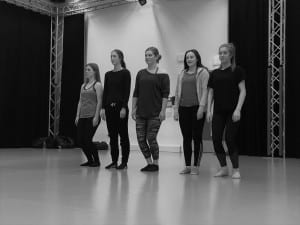From the reading ‘Composing while Dancing’ the information I gathered and sank in was that we are the image, we have to become them instead of just being a shape. I liked the idea of if ‘the image fades, you leave’ in The Red Square score of Barbara Dilley’s. Depending on how you take this in, you can either leave the space or pursue and create a new image.
I thought it was interesting how we developed the session. By the exercise being broken down, I found I got a better understanding of what each section consisted of. Starting with one person walking into the space with the eyes closed was daunting in a way. When I went into the space I had an image, but it could look completely different to what I thought because I didn’t have my vision to help. The development of this was another participant to come join and complete the image. Simple as this sounds, it could actually be quite challenging. I felt the need to somehow make it interesting to the eye. What will my image communicate? How will someone respond?
Most of the session I was an observer. Observing helped me think about my movement material and what movements I can gain from others. I needed this because in the previous week I felt I struggled and stuck to my habitual movements more than I normally do.
